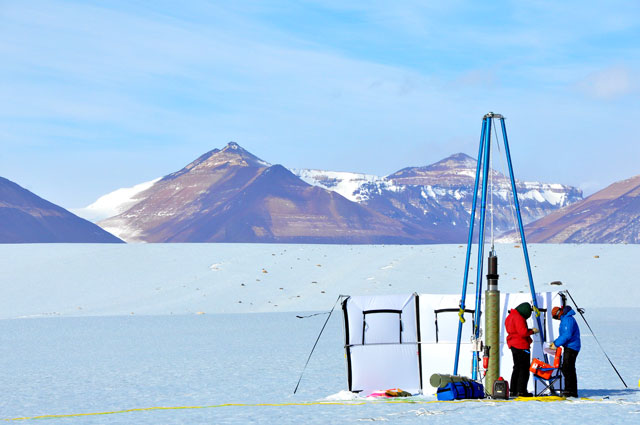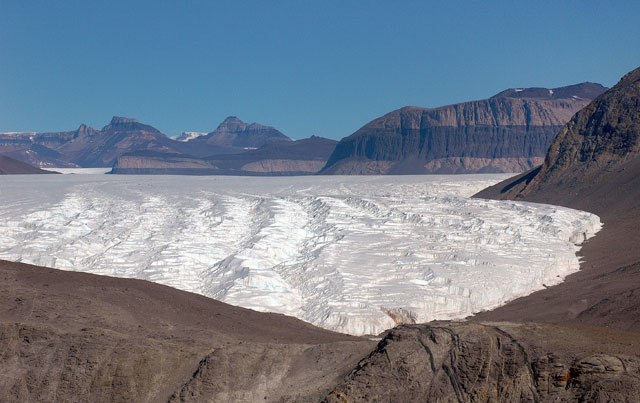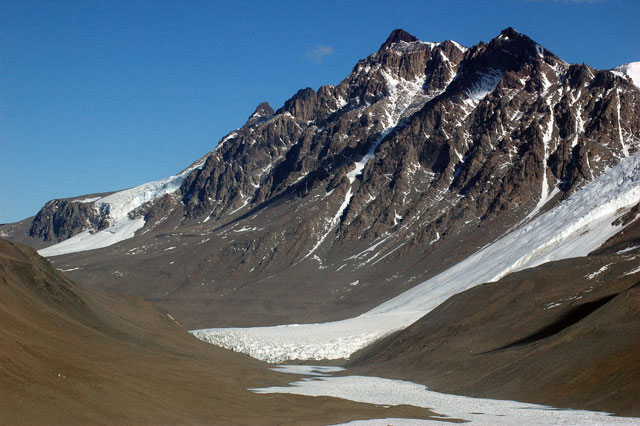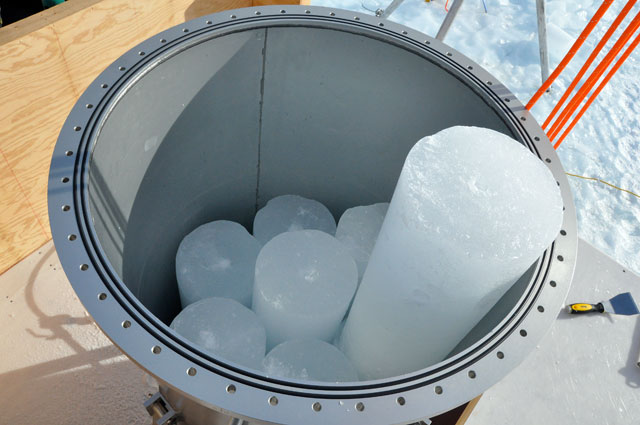On the surfaceScientists find old ice for climate studies at top of Antarctic glacierPosted July 22, 2011
Nearly 13,000 years ago, the Northern Hemisphere suddenly plunged back into a mini-ice age not long after emerging from a 100,000-year-long glacial period. A thousand years or so later — and likely just as quickly — it ended, and the current interglacial warm period returned. Such abrupt climate changes interest scientists looking for clues on how the Earth’s climate might behave in the future. The prevalent (though by no means definitive) theory behind cause of the Younger Dryas, named after the white flower that grows near glaciers, involves the shutdown of ocean circulation in the northern Atlantic Ocean by the influx of fresh water when the North American ice sheets melted. The catalyst behind the end of the Younger Dryas about 11,500 years ago is even more ambiguous. Concentration levels of the powerful but short-lived greenhouse gas methane rose by 50 percent at the time, with temperatures also rising sharply. Where did all that additional methane come from? One popular theory holds that methane frozen in the ocean seafloor suddenly erupted, causing atmospheric concentrations to shoot up from about 500 parts per billion (ppb) to about 750 ppb in just 150 years. A competing hypothesis blames increased bacterial methane production in wetlands. Jeffrey Severinghaus Their approach uses the rare isotope carbon-14. Methane hydrates trapped by cold and pressure in the ocean floor contain virtually no carbon-14, while methane from wetlands or other natural sources (think the natural bodily function of cows) will have trace amounts of the heavier carbon isotope. If methane hydrates were the culprit, the ratio of carbon-14 in the atmosphere would drop — sort of like diluting a cocktail by adding more nonalcoholic liquid. If not, the amount of carbon-14 would remain constant. “The trouble is that it takes a ton of ice for one carbon-14 measurement. You can’t get that from an ice core. That’s where the horizontal ice core comes in,” said Severinghaus, a professor of geosciences at Scripps Institution of Oceanography Severinghaus and his team, including co-principal investigator Ed Brook Ice cores are important recorders of past climate, including bubbles of atmospheric gases that were trapped at the time when the snow fell. Vertical ice cores can travel back in time to almost a million years, offering a rare and reliable window into past climate. But extraction of such ice to near the bottom of an ice sheet can take years and cost millions of dollars. And then there’s only a very finite amount of ice available to researchers to use for various analyses. For example, at an ice-coring site in West Antarctica, where the layers are thick enough to provide annual resolution for up to 40,000 years, ice of the age that Severinghaus and Brook need for their study is about 2,000 meters deep. On Taylor Glacier, 12,000-year-old ice is right at the surface in a 30-kilometer area known as blue ice. Snow covers most of Antarctica, but in blue ice areas, wind scours the snow from the surface. Sublimation — a process that turns snow immediately into water vapor in the air — takes care of the rest. Blue ice areas generally form where subglacial features obstruct ice flow, pushing the ice below to the surface. “As you walk along the surface, you’re walking through time,” Severinghaus explained. He added that the stratigraphic layers are prominent enough to be seen from the air. “You can almost do geology from space.” Severinghaus and Brook are one of the few teams making use of blue ice for such climate research. Andrei Kurbatov Kurbatov’s ice may be as old as 2.5 million years. The surface ice at Taylor Glacier isn’t nearly that old. Severinghaus said he estimates the ice at the snout of the glacier may be about 150,000 years old. “It’s kind of exciting. Nobody knew how old that ice was,” he said. The team collected about eight tons of ice using a new drill designed and built by the Ice Drilling Design and Operations Most of the ice collected was melted at the field camp, using a vacuum to suck the trapped gases into a tank for later analysis. A small amount of ice was preserved for additional lab work that will examine other gases that will help date the ice, which is highly compressed (something on the order of 300 years per meter) and without the annual layers available from vertical cores. Previous work by Severinghaus, Brook and colleagues using Greenland ice for similar analyses indicated that the elevated methane levels at the end of the Younger Dryas were not from the seafloor hydrates. The Antarctic ice experiment may help confirm that result or deepen the mystery. “There have been estimates that releasing even 1 percent of the methane hydrates in the seafloor could double the atmospheric concentration of methane,” Brook said previously when discussing the Greenland results. Current methane levels are about 1,800 ppb. While a far more powerful greenhouse gas than carbon dioxide, concentration levels are far lower for methane. CO2 is measured in part per million (ppm), and currently sitting at about 390 ppm. “There’s a lot of interest in trying to understand these abrupt climate changes because they might tell us something about our future,” said Severinghaus, whose team will return to the Taylor Glacier for more fieldwork in 2011-12. “It’s unlikely we’re going to trigger one, but it can tell us about the mechanism of how the Earth’s climate system works and if there might be surprises in the future, if the same gears and wheels that were activated back then are turned back on.”
NSF-funded research in this story: Jeffrey Severinghaus, University of California-San Diego Scripps Institution of Oceanography, Award No. 0839031 |



For USAP Participants |
For The Public |
For Researchers and EducatorsContact UsU.S. National Science FoundationOffice of Polar Programs Geosciences Directorate 2415 Eisenhower Avenue, Suite W7100 Alexandria, VA 22314 Sign up for the NSF Office of Polar Programs newsletter and events. Feedback Form |





